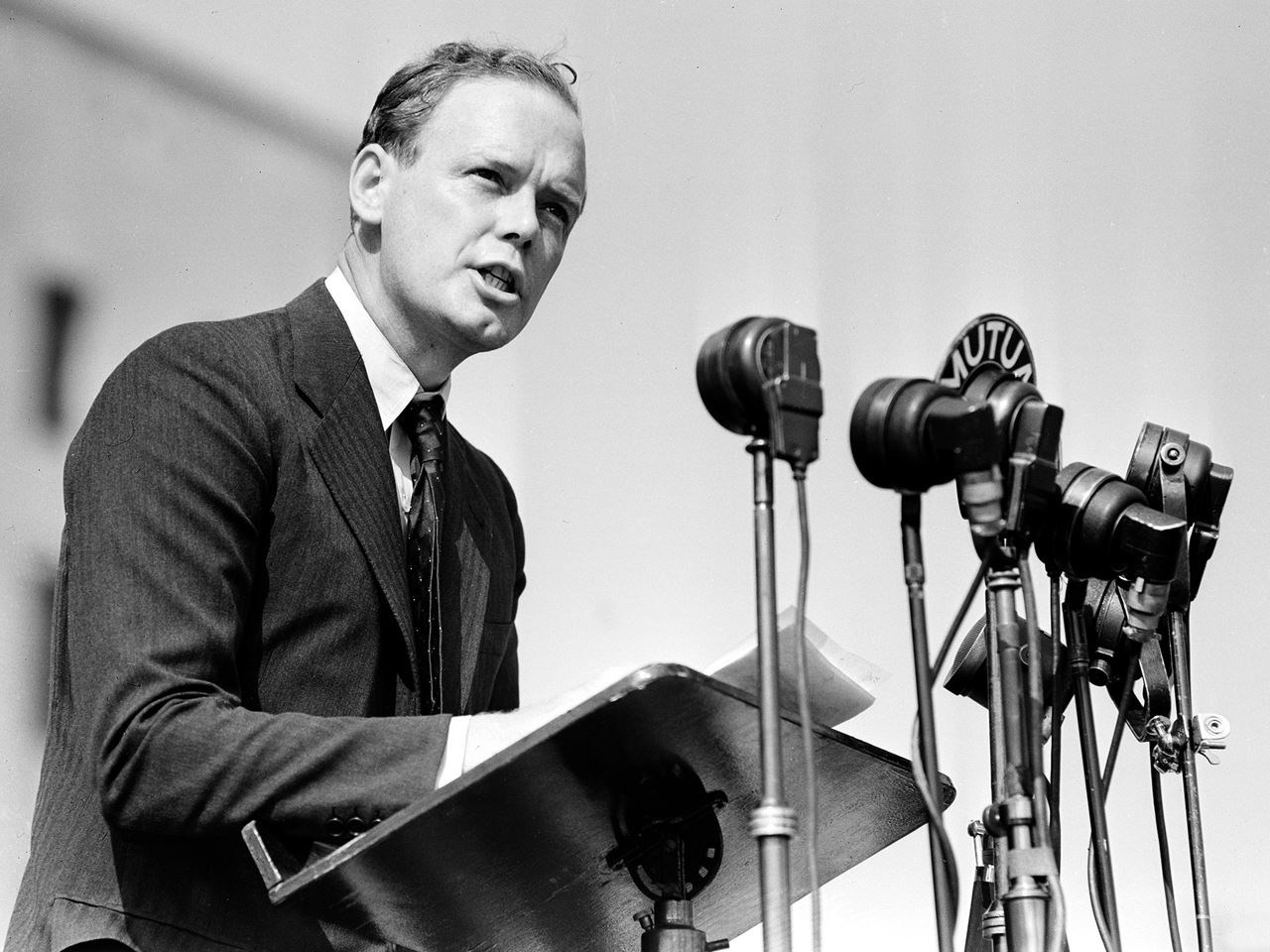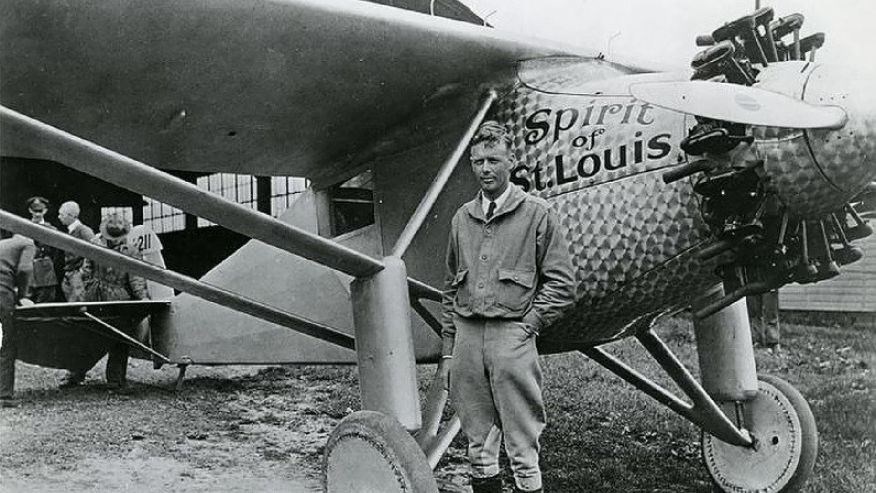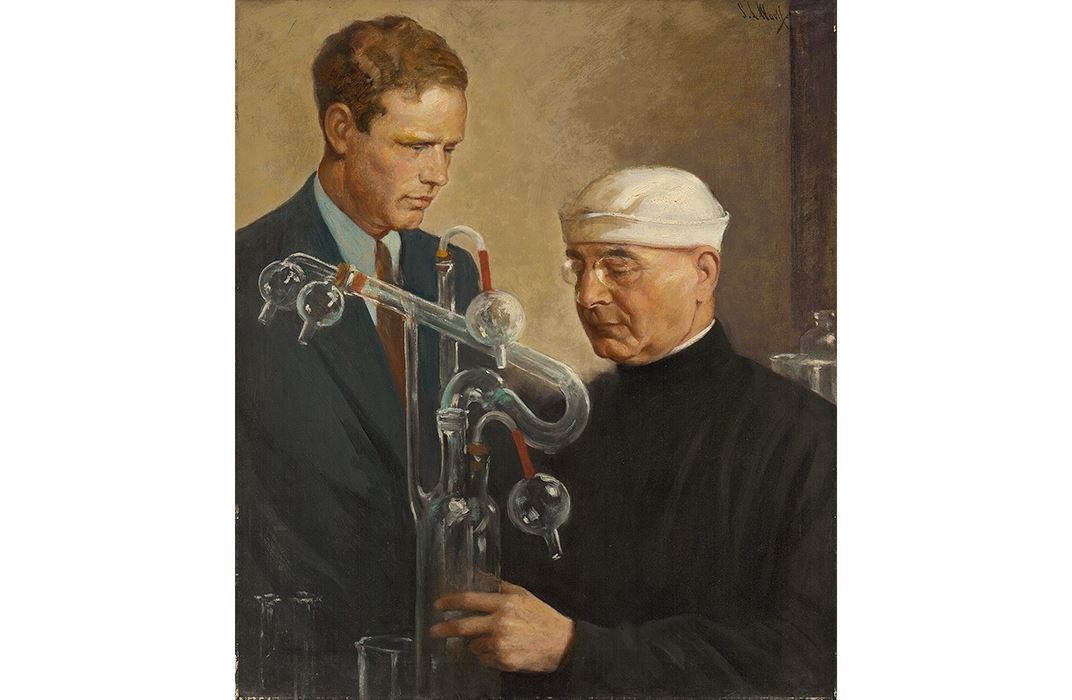 Lindbergh giving a speechhttps://www.northcountrypublicradio.org/news/npr/259385391/angry-days-shows-an-america-torn-over-entering-world-war-iiLindbergh’s genuine courage allowed him to accomplish his dreams and inspired many to follow his steps. Although Lindbergh wasn’t the first person to fly across the Atlantic, he was the first to fly solo across. Many other aviators before him have died or disappeared in an attempt. “The non-stop New York to Paris flight was a dream of many great aviators, and they had failed — many of them tragically — to achieve it. Six, all with sterling war records, had died or disappeared trying”(Kessner Para. 1). Although Lindbergh knew that attempting such a huge feat would put his own life on the line, he went ahead to do so. Such a huge risk takes a herculean amount of effort for someone to build up the courage in order to take on such a task, in which Lindbergh accomplished. Not only did Lindbergh accomplish the task of flying from New York to Paris, he also volunteered to fight for the US in World War 2. Even though he was prevented from joining the army due to his “America First” views, he still took part in the war effort and persisted to join the fight. ”But he was determined to fight in some capacity and eventually was allowed to become a civilian consultant to various wartime aviation companies”(Callan 28). Although President Roosevelt personally intervened when Lindbergh enlisted in the United States Army Air Corps, Lindbergh still looked for ways to support the war effort, ranging from being a test pilot to even flying multiple combat missions over the Pacific. Many people wanted to enlist in the Army during World War 2, but it was very rare for a celebrity to enlist, especially when they persist on joining the war effort after being denied. Lindbergh’s genuine courage allowed him to accomplish many things and complete his goals. He inspired many to follow his footsteps and risked his own safety for certain causes.
Lindbergh giving a speechhttps://www.northcountrypublicradio.org/news/npr/259385391/angry-days-shows-an-america-torn-over-entering-world-war-iiLindbergh’s genuine courage allowed him to accomplish his dreams and inspired many to follow his steps. Although Lindbergh wasn’t the first person to fly across the Atlantic, he was the first to fly solo across. Many other aviators before him have died or disappeared in an attempt. “The non-stop New York to Paris flight was a dream of many great aviators, and they had failed — many of them tragically — to achieve it. Six, all with sterling war records, had died or disappeared trying”(Kessner Para. 1). Although Lindbergh knew that attempting such a huge feat would put his own life on the line, he went ahead to do so. Such a huge risk takes a herculean amount of effort for someone to build up the courage in order to take on such a task, in which Lindbergh accomplished. Not only did Lindbergh accomplish the task of flying from New York to Paris, he also volunteered to fight for the US in World War 2. Even though he was prevented from joining the army due to his “America First” views, he still took part in the war effort and persisted to join the fight. ”But he was determined to fight in some capacity and eventually was allowed to become a civilian consultant to various wartime aviation companies”(Callan 28). Although President Roosevelt personally intervened when Lindbergh enlisted in the United States Army Air Corps, Lindbergh still looked for ways to support the war effort, ranging from being a test pilot to even flying multiple combat missions over the Pacific. Many people wanted to enlist in the Army during World War 2, but it was very rare for a celebrity to enlist, especially when they persist on joining the war effort after being denied. Lindbergh’s genuine courage allowed him to accomplish many things and complete his goals. He inspired many to follow his footsteps and risked his own safety for certain causes. Charles Lindbergh standing in front of the Spirit of St. Louishttps://a57.foxnews.com/images.foxnews.com/content/fox-news/opinion/2017/05/20/day-charles-lindbergh-changed-our-world-forever/_jcr_content/par/featured_image/media-0.img.jpg/876/493/1495291472348.jpg?ve=1&tl=1Besides his courage, Lindbergh also helped develop technology in aviation and the medical field. Lindbergh designed a sleek plane, which was as light as possible, to cross the Atlantic. He also helped design a machine that would sustain the heart while taken out of the body. “Charles Lindbergh, an unknown postal flier, challenged this approach. He scraped together the money for a craft of his own design: tiny, sleek, and as light as possible (not even a radio). He would make the 33 hour trip alone on a course he had sketched out himself”(Kessner Para. 2). While preparing for his flight across the Atlantic, Lindbergh came up with a different idea for the plane he was going to fly. Many people at that time believed that the best way to cross was to build the biggest plane you could and put the most engines you can on the plane. However, Lindbergh’s concept was different and efficient. His plane, the Spirit of St. Louis, successfully transported him across the Atlantic. Not only did Lindbergh come up with an ingenious design for an airplane, he also found a way to keep your heart beating when it’s outside your body. “After asking his doctor why surgery could not reverse the damage, Lindbergh was told that the procedure would take longer than the heart could be removed from the body without causing permanent damage. Lindbergh persisted. Why couldn’t a machine be used to sustain the live organ, he reasoned”(Redman Para. 9). According to Smithsonian Magazine, Lindbergh, motivated to find a way to keep the heart alive while outside of a person’s body, partnered with a scientist to create this machine. Although he is not well known for inventing this machine, it was still a very innovative way to sustain the heart while outside a person’s body. Lindbergh’s innovative ideas helped shape the world we live in today and has helped many of those in need. He contributed greatly to the aviation and medical field.
Charles Lindbergh standing in front of the Spirit of St. Louishttps://a57.foxnews.com/images.foxnews.com/content/fox-news/opinion/2017/05/20/day-charles-lindbergh-changed-our-world-forever/_jcr_content/par/featured_image/media-0.img.jpg/876/493/1495291472348.jpg?ve=1&tl=1Besides his courage, Lindbergh also helped develop technology in aviation and the medical field. Lindbergh designed a sleek plane, which was as light as possible, to cross the Atlantic. He also helped design a machine that would sustain the heart while taken out of the body. “Charles Lindbergh, an unknown postal flier, challenged this approach. He scraped together the money for a craft of his own design: tiny, sleek, and as light as possible (not even a radio). He would make the 33 hour trip alone on a course he had sketched out himself”(Kessner Para. 2). While preparing for his flight across the Atlantic, Lindbergh came up with a different idea for the plane he was going to fly. Many people at that time believed that the best way to cross was to build the biggest plane you could and put the most engines you can on the plane. However, Lindbergh’s concept was different and efficient. His plane, the Spirit of St. Louis, successfully transported him across the Atlantic. Not only did Lindbergh come up with an ingenious design for an airplane, he also found a way to keep your heart beating when it’s outside your body. “After asking his doctor why surgery could not reverse the damage, Lindbergh was told that the procedure would take longer than the heart could be removed from the body without causing permanent damage. Lindbergh persisted. Why couldn’t a machine be used to sustain the live organ, he reasoned”(Redman Para. 9). According to Smithsonian Magazine, Lindbergh, motivated to find a way to keep the heart alive while outside of a person’s body, partnered with a scientist to create this machine. Although he is not well known for inventing this machine, it was still a very innovative way to sustain the heart while outside a person’s body. Lindbergh’s innovative ideas helped shape the world we live in today and has helped many of those in need. He contributed greatly to the aviation and medical field. Lindbergh's glass chambered perfusion pumphttps://www.smithsonianmag.com/smithsonian-institution/save-his-dying-sister-law-charles-lindbergh-Invented-medical-device-180956526/
Lindbergh's glass chambered perfusion pumphttps://www.smithsonianmag.com/smithsonian-institution/save-his-dying-sister-law-charles-lindbergh-Invented-medical-device-180956526/  Lindbergh and his wife in Nazi Germanyhttps://worldwarwings.com/charles-lindbergh-nazi-sympathizer/Lindbergh’s genuine courage and innovative ideas prove that he is not only an idol or someone with fame, but also someone who is considered a hero. Lindbergh ventured across the Atlantic, knowing the chances of him not making it across very high. However, he still pursued his goal and achieved it. He persisted to fight for the American cause during World War II. Not only that, but he also contributed to the scientific field by inventing the perfusion pump and contributed to the aviation aspect such as cruise control and developing more advanced airplanes, eventually turning to the space program. Although many knew him as a Nazi sympathizer, Lindbergh still displays the traits of a hero who inspires and pursues their goals.
Lindbergh and his wife in Nazi Germanyhttps://worldwarwings.com/charles-lindbergh-nazi-sympathizer/Lindbergh’s genuine courage and innovative ideas prove that he is not only an idol or someone with fame, but also someone who is considered a hero. Lindbergh ventured across the Atlantic, knowing the chances of him not making it across very high. However, he still pursued his goal and achieved it. He persisted to fight for the American cause during World War II. Not only that, but he also contributed to the scientific field by inventing the perfusion pump and contributed to the aviation aspect such as cruise control and developing more advanced airplanes, eventually turning to the space program. Although many knew him as a Nazi sympathizer, Lindbergh still displays the traits of a hero who inspires and pursues their goals.Works Consulted
Andrews, Evan. “10 Fascinating Facts About Charles Lindbergh.” History.com, A&E Television Networks, 26 Aug. 2014, www.history.com/news/history-lists/10-fascinating-facts-about-charles-lindbergh.
Charles Lindbergh Biography, www.charleslindbergh.com/history
Redman, Emily. “To Save His Dying Sister-In-Law, Charles Lindbergh Invented a Medical Device.” Smithsonian.com, Smithsonian Institution, 9 Sept. 2015, www.smithsonianmag.com/smithsonian-institution/save-his-dying-sister-law-charles-lindbergh-Invented-medical-device-180956526/.
McKenna, Bill. “Charles Lindbergh, the Nazis and American Isolationism.” Charles Lindbergh, the Nazis and American Isolationism, BBC News, 6 June 2013, www.bbc.com/news/av/magazine-22684773/charles-lindbergh-the-nazis-and-american-isolationism
Charles Lindbergh, a New Hero.” OUPblog, 16 May 2012, blog.oup.com/2012/05/charles-lindbergh-a-new-hero/.
History.com Staff. “Charles A. Lindbergh.” History.com, A&E Television Networks, 2009, www.history.com/topics/charles-a-lindbergh.
Charles Lindbergh (1902 – 1974).” Charles Lindbergh - Historic Missourians - The State Historical Society of Missouri, shsmo.org/historicmissourians/name/l/lindbergh/
Page created on 2/13/2018 6:43:04 PM
Last edited 9/8/2018 3:29:52 PM
